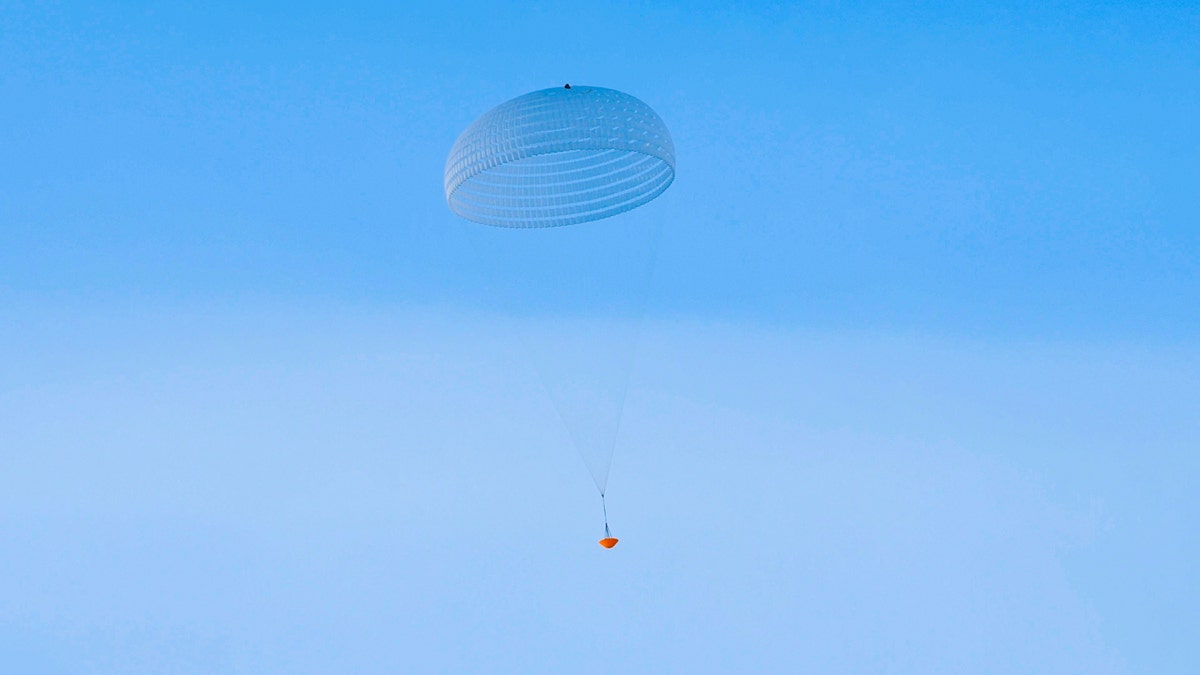
A prototype for a giant 115-foot (35 meters) parachute for the European Space Agency's ExoMars rover has passed its first drop test from a helicopter. (I.Barel/ESA)
The largest-ever parachute bound for Mars, which will land Europe's ExoMars rover on the surface of the Red Planet in 2021, passed the first in a series of tests in Sweden.
The ring-slot parachute is 115 feet (35 meters) across, weighs almost 200 lbs. (90 kilograms) and is equipped with 3 miles (5 kilometers) of cords. According to a video by the European Space Agency (ESA), which oversees ExoMars, it takes five working days to prepare and fold the parachute into its correct configuration.
For the recent test, a helicopter carried the 1,100-lb. (500 kg) test landing module to an altitude of about 4,000 feet (1,200 meters) and dropped it from that height. After a 12-second free fall, the parachute deployment sequence was initiated, starting with the opening of a smaller, 15.7-foot (4.8 m) pilot chute, which then triggered the opening of the second, main parachute. The whole 430-lb. (195 kg) parachute system was connected to the test landing module with 112 lines. [Photos: Europe's ExoMars Missions to Mars in Pictures]
"The objective of this test was to check how the parachute would be extracted from the bag and the first inflation of the parachute," Stephane Langlois, ExoMars engineer at ESA, said in the video. "What we are trying to do with this test is not to represent the Mars atmosphere. If we would like to do that, we would have to go to a very high altitude, and that is another test, which we plan to do later this year."
More From Space.com
Multiple GoPro cameras mounted on the test module monitored the deployment of the two parachutes. During the entire experiment, engineers were receiving telemetry data, which they will now review together with the camera footage before proceeding to the high-altitude test later this year, the researchers said.
"The successful deployment of our large ExoMars parachute using a smaller pilot chute and its subsequent stable descent without damage is a major milestone for the project," ExoMars project manager Thierry Blancquaert, also of ESA, said in the video.
"It was a very exciting moment to see this giant parachute unfurl and deliver the test module to the snowy surface in Kiruna [Sweden], and we're looking forward to assessing the full parachute descent sequence in the upcoming high-altitude tests," Blancquaert added.
According to John Underwood, principal engineer at Vorticity, a U.K.-based ESA contractor that developed the parachute, in the next test, the whole system will be carried by a helium balloon to an altitude of 17 miles (28 km), where Earth's atmosphere is as thin as that of Mars. From that altitude, the engineers will be able to run the whole parachute deployment sequence, which involves not one but two giant parachutes.
According to ESA, the ExoMars mission will need two such parachutes because the landing module will weigh some 4,400 lbs. (2,000 kg).
"For the ExoMars 2020 mission, the parachute is used to decelerate the descent module during its entry to the Mars atmosphere," Langlois said. "We are using the first pilot chute, which will extract a 15m [49 feet] supersonic parachute. When we reach the subsonic velocity of Mach 0.8, we have a second pilot chute, which will extract the 35m [115 feet] ring-slot parachute, which we recently tested."
The ExoMars mission is scheduled to launch in July 2020 with an expected Martian landing in March 2021.
The ExoMars rover, which is currently being built in the U.K., will use a 6.5-foot (2 m) drill to extract samples from below the planet's surface, in the search for life. Scientists believe that if there ever was life on Mars, evidence of it most likely survived under the planet's crust, where it would be protected from the harsh radiation and extreme conditions on the surface.
In addition to the parachute system, the landing module will be fitted with an aero-braking heat shield, a damping system and breaking thrusters, which will eventually place the module onto the surface.
Original article on Space.com.
